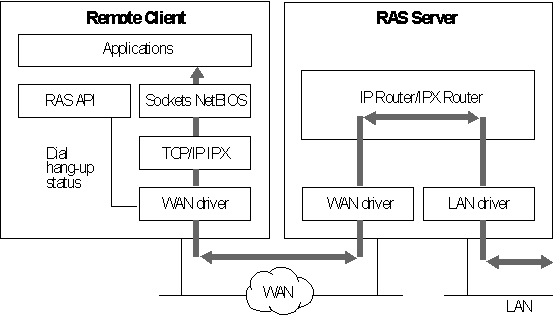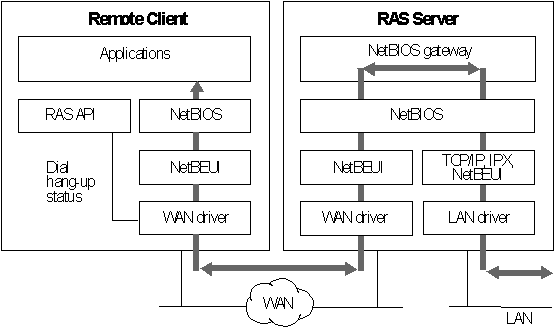
Because LAN's are evolving quickly from islands of information to fully-connected networks of diverse operating systems, protocols, and file systems, Microsoft has defined interoperability as a key feature in Windows NT and RAS and has concentrated on the following areas to ensure smooth integration into the heterogeneous networks of today and tomorrow:
Microsoft's Remote Access Service offers the broadest hardware support of any remote access vendor. Currently, over 1,700 computers, 300 modems, and 11 multi-port serial adapters are supported. By selecting a remote access solution with very broad hardware support, customers can gain flexibility in their system design. A complete listing of the hardware devices supported by RAS can be found in the Windows NT Hardware Compatibility List (HCL). The HCL ships with Windows NT, and can also be found on the Microsoft Download Service (206-936-MSDL) or on CompuServe (GO WINNT).
Previous versions of RAS functioned as NetBIOS gateways. Users would make their connections using NetBEUI/ NetBIOS, and then inherit other protocols from the server. This method enabled users to share network resources in a multi-vendor LAN environment, but limited them from running applications which relied on the presence of a protocol other than NetBEUI on the client-side. The enhanced architecture is as follows:

Figure 9.2 PPP Architecture
While this architecture continues to support the NetBIOS gateway, it also offers some exciting new possibilities. This architecture enables clients to load any combination of NetBEUI, IPX, and TCP/IP. Applications written to the Windows Sockets, NetBIOS, or IPX interface can now be run on a Windows NT Workstation. This architecture will be the basis for the RAS client in Windows95 as well.
Multi-protocol routing is just one of the benefits of Microsoft's move to the Point-to-Point Protocol (PPP) in RAS. The Point-to-Point Protocol is a set of industry standard protocols that enable remote access solutions to interoperate in a multi-vendor network. PPP support in Windows NT 3.5 and Windows95 means that workstations running Windows can dial into remote networks through any industry-standard PPP server. It also enables a Windows NT Server to receive calls from, and provide network access to, other vendors' remote access workstation software.
And while multi-protocol support is an important new feature of Microsoft's RAS, NetBIOS gateway support continues to be an important part of its feature set.

Figure 9.3 NetBIOS Gateway Architecture
An example of the NetBIOS gateway capability is remote network access for Lotus Notes users. While Lotus Notes does offer dial-up connectivity, dial up is limited to the Notes application only. RAS complements this connectivity by providing a low-cost, high-performance remote network connection for NotesÒ users, which not only connects Notes, but offers file and print services, and access to other network resources.
Many customers who are interested in PPP interoperability, are also concerned with SLIP. SLIP, the Serial Line Internet Protocol, is an older communications standard found in UNIX environments. SLIP does not provide automatic negotiation of network configuration; it requires user intervention. It also does not support encrypted authentication. Microsoft supports SLIP on the client side, so that the clients running Windows NT 3.5 may dial into an existing SLIP server. RAS does not provide a SLIP server in Windows NT version 3.5.